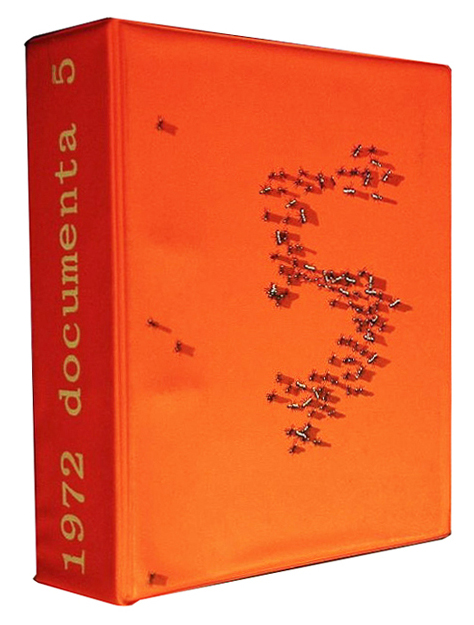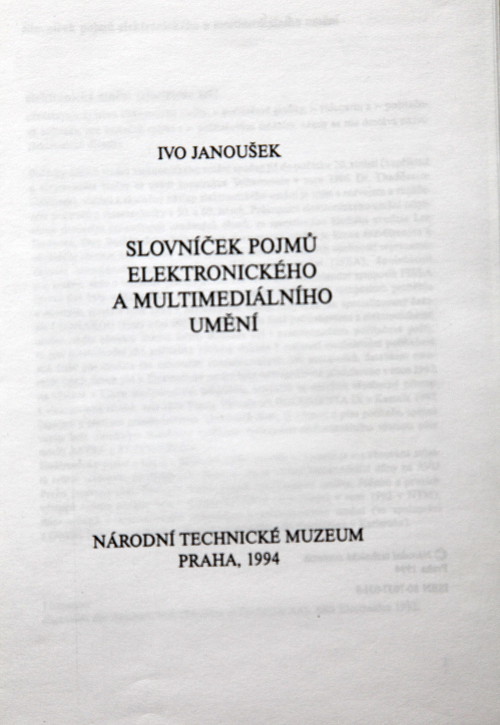Harald Szeemann, et al.: Documenta 5, catalogue (1972) [DE]
Filed under catalogue | Tags: · advertising, art, conceptual art, film, institutional critique, light art, museum, outsider art, performance art, politics, propaganda, realism, science fiction, systems art, utopia

“Even decades later, Documenta 5, the exhibition that was criticized in 1972 as being “bizarre.. vulgar.. sadistic” by Hilton Kramer (NYT) and “monstrous.. overtly deranged” by Barbara Rose (NYM), resonates today as one of the most important exhibitions in history. Both hailed and derided by artists and critics, the exhibition was the largest, most expensive and most diverse of any exhibition anywhere, and foreshadowed all large-scale, collaboratively curated, comprehensive mega-shows to come.
Chiefly curated by the Swiss curator, Harald Szeemann, it was a pioneering, radically different presentation that was conceived as a 100-day event, with performances and happenings, outsider art, even non-art, as well as repeated Joseph Beuys lectures, and an installation of Claes Oldenburg’s Mouse Museum, among many other atypical inclusions. The show widely promoted awareness of a contract known as The Artist’s Reserved Rights Transfer and Sale Agreement, which protects artists’ ongoing intellectual and financial rights with regard to their production.” (Source)
“Featuring the works of over 170 artists and an equally expansive variety of materials and subjects drawn from popular cultural materials such as science fiction publications, kitsch objects, exploitation films, as well as advertising imagery, in addition to the more anticipated painting and sculpture – Documenta 5 valiantly attempted to bridge the gap between art, culture, science and the broader society.
A lasting highlight of the exhibition was the graphic logo for the show designed by Edward Ruscha. Commissioned by Szeeman, Ruscha’s graphic image for the show featured ants arranged in the word ‘Docu / menta’ and the number ‘5.’ The emblem was used on the exhibition’s poster and catalogue cover.” (Source)
Contents of Part B:
1 Hans Heinz Holz: Kritische Theorie des ästhetischen Zeichens (catalogue foreword, 86 pp),
2 Bazon Brock & Karl Heinz Krings: Audiovisuelles Vorwort (audiovisual foreword, 19 pp),
3 Eberhard Roters: Trivialrealismus & Trivialemblematik (16 pp),
4 Ingolf Bauer: Bilderwelt und Froemmigkeit (10 pp),
5 Gesellschaftliche Ikonographie an zwei Beispielen (8 pp),
6 Charles Wilp, Hans Heinz Holz: Werbung (4 pp),
7 Reiner Diederich, Richard Grübling, Klaus Staeck: Politische Propaganda (14 pp),
8 Pierre Versins: Science Fiction/Heute von gestern gesehen (10 pp),
9 François Burkhardt: Utopie/Morgen von gestern gesehen (16 pp),
10 Ursula Barthelmess, Hans-Henning Borgelt, Linde Burkhardt, Wolfgang Hoebig: Spiel und Wirklichkeit (14 pp),
11 Theodor Spoerri: Bildnerei der Giesteskranken (18 pp),
12 Gerhard Buettenbender, Sigurd Hermes: Film (28 pp),
13 Museen von Künstlern (17 pp),
14 Sozialistischer Realismus (1 p),
15 Jean-Christophe Ammann: Realismus (58 pp),
16 Johannes Cladders, Harald Szeemann: Individuelle Mythologien – Selbstdarstellung: a) Performance, b) Film – Prozesse (220 pp),
17 Konrad Fischer, Klaus Honnef, Gisela Kaminski: Idee + Idee / Licht (92 pp),
18 Information + The Artist’s Reserved Rights Transfer and Sale Agreement (44 pp),
19 Verzeichnis der ausgestellten Werke
20 Allgemeine Bibliographie
21 Waehrend: Ereigniskalender
22 Nachher 1: Text
23 Nachher 2: Bild
24 Nachher 3: Presse
25 Fotonachweis
documenta 5. Befragung der Realität – Bildwelten heute
Edited by Harald Szeemann, Marlis Grüterich, Katia von den Velden, Jennifer Gough-Cooper
Publisher documenta and Bertelsmann, Kassel, 1972
ISBN 3570028569, 9783570028568
64+80 & 740+ pages
via The DOR (at Archive.org)
Analyses and commentaries:
3sat TV documentary (video, 41 min, 1972, DE)
Der Spiegel (1972, DE)
Klaus Herding & Hans-Ernst Mittig on Holz’s foreword (Kritische Berichte, 1973, DE)
Documenta 5 in Art Since 1900 (2004, EN)
Dirk Schwarze (Documenta Archiv, 2014, DE)
Maria Bremer (Stedelijk Studies, 2015, EN)
documenta Archiv, (2)
Wikipedia (DE)
WorldCat
Part A (144 pp, PDF, 57 MB)
Part B (740+ pp, PDF, 287 MB, sections 19-24 missing; updated on 2023-3-28)
Josef Albers: Glass, Color, and Light (1994)
Filed under catalogue | Tags: · architecture, art, colour, glass, light art

Josef Albers (1888-1976), famous as a master at Germany’s Bauhaus until 1933, and then a professor in American schools such as Yale University, influenced many young artists. His Homage to the Square series of paintings remains an important example of 20th-century art. Yet Albers’s first great works – the glass pictures that he made in Germany beginning in 1921 – remain little known. Starting with found fragments of colored glass, and later employing a sophisticated sandblasting process, Albers created a new art form.
Glass, Color and Light is the first monograph devoted to Albers’s work in this medium. Reproductions, 62 in color, of every extant glass picture are accompanied by full documentation by Brenda Danilowitz of the Josef Albers Foundation. Also illustrated and discussed are Albers’s architectural commissions in glass and those works that were lost or destroyed after the artist fled Nazi Germany. Essays by Nicholas Fox Weber, executive director of the Josef Albers Foundation, and Fred Licht, curator of the Peggy Guggenheim Collection, illuminate the many themes suggested by this extraordinary group of works, while a chronology of Albers’s life and professional career places the glass works in the context of his entire oeuvre.
Publisher Guggenheim Museum Publications, New York, 1994
ISBN 0810968649
152 pages
via Archive.org
Ivo Janoušek: Slovníček pojmů elektronického a multimediálního umění (1994) [Czech]
Filed under booklet | Tags: · art, computer art, electronic art, light art, multimedia, video art

Pojmy: elektronické umění (electronic art), kybernetické umění (cybernetic art), multi-média, počítačová animace (computer animation), počítačový design (computer design) / CAD (Computer Aided Design), počítačová grafika (computer graphics), počítačové umění (computer art), světelné umění (Light Art), totální umění, videoart.
Publisher Národní technické muzeum, Prague, 1994
ISBN 8070370319, 9788070370315
18 pages
via Michal Murin
PDF (no OCR)
Comment (0)
